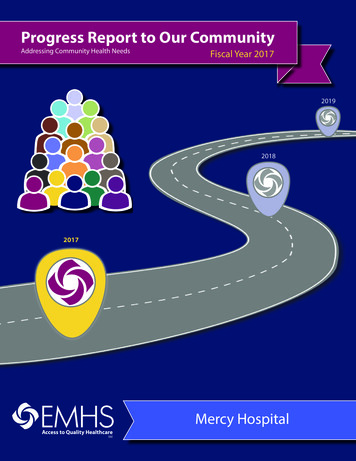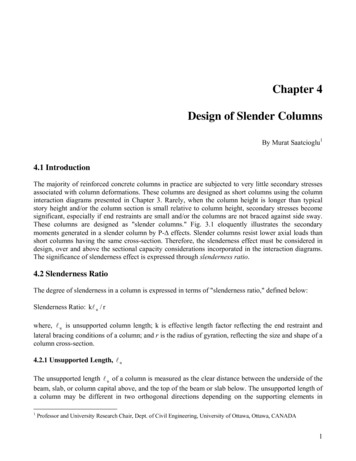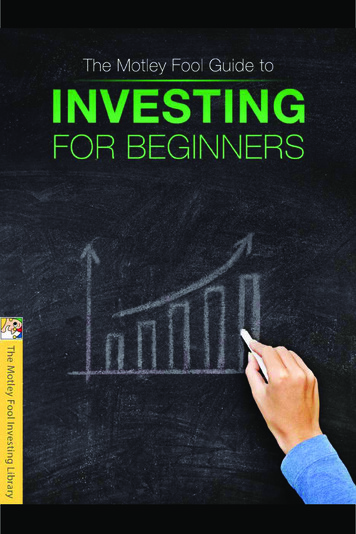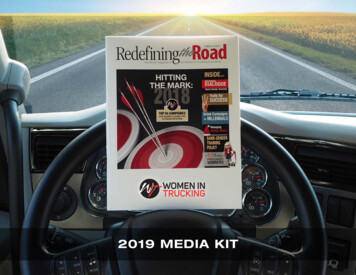
Transcription
Milestone MomentsLearn the Signs. Act Early.Learn the Signs. Act Early.www.cdc.gov/Milestones1-800-CDC-INFO (1-800-232-4636)Adapted from CARING FOR YOUR BABY AND YOUNG CHILD: BIRTH TO AGE 5, Fifth Edition, edited by StevenShelov and Tanya Remer Altmann 1991, 1993, 1998, 2004, 2009 by the American Academy of Pediatrics andBRIGHT FUTURES: GUIDELINES FOR HEALTH SUPERVISION OF INFANTS, CHILDREN, AND ADOLESCENTS, ThirdEdition, edited by Joseph Hagan, Jr., Judith S. Shaw, and Paula M. Duncan, 2008, Elk Grove Village, IL: AmericanAcademy of Pediatrics.Special acknowledgements to Susan P. Berger, PhD; Jenny Burt, PhD; Margaret Greco, MD; Katie Green, MPH,CHES; Georgina Peacock, MD, MPH; Lara Robinson, PhD, MPH; Camille Smith, MS, EdS; Julia Whitney, BS; andRebecca Wolf, MA.Centers for DiseaseControl and 88Milestones Matter!Look inside for milestones to watch for in your child andtips for how you can help your child learn and grow.DownloadCDC’s MilestoneTracker App
Milestone MomentsHow your child plays, learns, speaks, acts, andmoves offers important clues about your child’sdevelopment. Developmental milestones are thingsmost children can do by a certain age.The lists that follow have milestones to look for when your child is:2 Months. page 3 – 64 Months. page 7 – 106 Months. page 11 – 149 Months. page 15 – 18Check the milestones your child has reached by each age.Take this booklet with you and talk to your child’s doctor at everywell-child visit about the milestones your child has reached andwhat to expect next.1 Year. page 19 – 2218 Months (1½ Years). page 23 – 262 Years. page 27 – 303 Years. page 31 – 34For more information,go to www.cdc.gov/Milestones or tryCDC’s FREE Milestone Tracker app!4 Years. page 35 – 385 Years. page 39 – 42Notes. page 43 – 461Learn the Signs. Act Early.www.cdc.gov/Milestones 1-800-CDC-INFO (1-800-232-4636)2
Your Baby by 2 MonthsTalk with your child’s doctor at every visit about the milestonesyour child has reached and what to expect next.What most babiesdo by this ageSocial/Emotional Milestonesq Can briefly calm himself(may bring hands to mouth andsuck on hand)How you can help your baby’s developmentq Begins to smile at people Cuddle, talk, and play with your baby during feeding, dressing, and bathing.q Tries to look at parent Help your baby learn to calm herself. It’s okay for her to suck onher fingers. Begin to help your baby get into a routine, such as sleeping at night morethan in the day, and have regular schedules.Language/Communication Milestonesq Coos, makes gurgling soundsq Turns head toward soundsCognitive Milestones (learning, thinking, problem-solving)q Pays attention to facesq Begins to follow things with eyesand recognize people at a distanceq Begins to act bored (cries, fussy)if activity doesn’t change Getting in tune with your baby’s likes and dislikes can help you feel morecomfortable and confident. Act excited and smile when your baby makes sounds. Copy your baby’s sounds sometimes, but also use clear language. Pay attention to your baby’s different cries so that you learn to know whathe wants. Talk, read, and sing to your baby. Play peek-a-boo. Help your baby play peek-a-boo, too. Place a baby-safe mirror in your baby’s crib so she can look at herself.3Learn the Signs. Act Early.www.cdc.gov/Milestones 1-800-CDC-INFO (1-800-232-4636)4
Your Baby by 2 MonthsMovement/Physical Development MilestonesHow you can help your baby’s developmentq Can hold head up and beginsto push up when lying ontummy Look at pictures with your baby and talk about them.q Makes smoother movementswith arms and legs Lay your baby on his tummy when he is awake and put toys near him. Encourage your baby to lift his head by holding toys at eye level in front of him. Hold a toy or rattle above your baby’s head and encourage her to reach for it. Hold your baby upright with his feet on the floor. Sing or talk to your babyas he is upright.Don’t wait. You know your child best.Act early if your child:q Is missing milestonesq Doesn’t smile at peopleq Doesn’t respond to loud soundsq Doesn’t bring hands to mouthq Doesn’t watch things as they moveq Can’t hold head up when pushingup when on tummyTell your child’s doctor or nurse if you notice any of these signs of possibledevelopmental delay and ask for a developmental screening.If you or the doctor is still concerned1. Ask for a referral to a specialist and,2. Call your state or territory’s early intervention program to find out if your childcan get services to help. Learn more and find the number at cdc.gov/FindEI.For more information, go to cdc.gov/Concerned.5Learn the Signs. Act Early.www.cdc.gov/Milestones 1-800-CDC-INFO (1-800-232-4636)6
Your Baby by 4 MonthsTalk with your child’s doctor at every visit about the milestonesyour child has reached and what to expect next.What most babiesdo by this ageHow you can help your baby’s developmentSocial/Emotional Milestonesq Smiles spontaneously, especiallyat peopleq Likes to play with people andmight cry when playing stopsq Copies some movements andfacial expressions, like smilingor frowningq Babbles with expression andcopies sounds he hears Set steady routines for sleeping and feeding. Pay close attention to what your baby likes and doesn’t like; you willknow how best to meet his needs and what you can do to make yourbaby happy. Copy your baby’s sounds.Language/Communication Milestonesq Begins to babble Hold and talk to your baby; smile and be cheerful while you do. Act excited and smile when your baby makes sounds.q Cries in different ways to showhunger, pain, or being tired Have quiet play times when you read or sing to your baby. Give age-appropriate toys to play with, such as rattles or colorfulpictures. Play games such as peek-a-boo. Provide safe opportunities for your baby to reach for toys and explorehis surroundings. Put toys near your baby so that she can reach for them or kick her feet.7Learn the Signs. Act Early.www.cdc.gov/Milestones 1-800-CDC-INFO (1-800-232-4636)8
Your Baby by 4 MonthsCognitive Milestones (learning, thinking, problem-solving)How you can help your baby’s developmentq Lets you know if she is happyor sadq Follows moving things with eyesfrom side to side Put toys or rattles in your baby’s hand and help him to hold them.q Responds to affectionq Watches faces closelyq Reaches for toy with one handq Recognizes familiar people andthings at a distanceq Uses hands and eyes together,such as seeing a toy andreaching for it Hold your baby upright with feet on the floor, and sing or talk to yourbaby as she “stands” with support.Movement/Physical Development Milestonesq Holds head steady, unsupportedq Pushes down on legs when feetare on a hard surfaceq May be able to roll over fromtummy to backq Can hold a toy and shake it andswing at dangling toysq Brings hands to mouthq When lying on stomach, pushesup to elbowsAct early if your child:Don’t wait. You know your child best.q Is missing milestonesq Doesn’t bring things to mouthq Doesn’t watch things as they moveq Doesn’t push down with legswhen feet are placed on ahard surfaceq Doesn’t smile at peopleq Can’t hold head steadyq Doesn’t coo or make soundsq Has trouble moving one or botheyes in all directionsTell your child’s doctor or nurse if you notice any of these signs of possibledevelopmental delay and ask for a developmental screening.If you or the doctor is still concerned1. Ask for a referral to a specialist and,2. Call your state or territory’s early intervention program to find out if your childcan get services to help. Learn more and find the number at cdc.gov/FindEI.For more information, go to cdc.gov/Concerned.9Learn the Signs. Act Early.www.cdc.gov/Milestones 1-800-CDC-INFO (1-800-232-4636)10
Your Baby by 6 MonthsTalk with your child’s doctor at every visit about the milestonesyour child has reached and what to expect next.What most babiesdo by this ageSocial/Emotional MilestonesHow you can help your baby’s developmentq Knows familiar faces and beginsto know if someone is a strangerq Responds to other people’semotions and often seems happyq Likes to play with others,especially parentsq Likes to look at self in a mirror Play on the floor with your baby every day. Learn to read your baby’s moods. If he’s happy, keep doing what you aredoing. If he’s upset, take a break and comfort your baby. Show your baby how to comfort herself when she’s upset. She may suckon her fingers to self soothe.Language/Communication Milestones Use “reciprocal” play—when he smiles, you smile; when he makessounds, you copy them.q Responds to sounds by makingsounds Repeat your child’s sounds and say simple words with those sounds.For example, if your child says “bah,” say “bottle” or “book.”q Strings vowels together whenbabbling (“ah,” “eh,” “oh”) andlikes taking turns with parentwhile making soundsq Responds to own nameq Makes sounds to show joy anddispleasureq Begins to say consonant sounds(jabbering with “m,” “b”) Read books to your child every day. Praise her when she babbles and“reads” too. When your baby looks at something, point to it and talk about it. When he drops a toy on the floor, pick it up and give it back. This gamehelps him learn cause and effect. Read colorful picture books to your baby.11Learn the Signs. Act Early.www.cdc.gov/Milestones 1-800-CDC-INFO (1-800-232-4636)12
Your Baby by 6 MonthsCognitive Milestones (learning, thinking, problem-solving)How you can help your baby’s developmentq Looks around at things nearbyq Brings things to mouth Point out new things to your baby and name them.q Shows curiosity about thingsand tries to get things that areout of reachq Begins to pass things from onehand to the other Show your baby bright pictures in a magazine and name them.Movement/Physical Development Milestonesq Rolls over in both directions(front to back, back to front)q When standing, supports weighton legs and might bounce Hold your baby up while she sits or support her with pillows. Let her lookaround and give her toys to look at while she balances. Put your baby on his tummy or back and put toys just out of reach.Encourage him to roll over to reach the toys.q Begins to sit without supportq Rocks back and forth, sometimescrawling backward beforemoving forwardAct early if your child:Don’t wait. You know your child best.Tell your child’s doctor or nurse if you notice any of these signs of possibledevelopmental delay and ask for a developmental screening.q Is missing milestonesq Seems very floppy, like a rag dollq Doesn’t try to get things that arein reachq Doesn’t make vowel sounds(“ah”, “eh”, “oh”)q Shows no affection for caregiversq Doesn’t roll over in either directionq Doesn’t respond to soundsaround himq Doesn’t laugh or make squealingsounds1. Ask for a referral to a specialist and,2. Call your state or territory’s early intervention program to find out if your childcan get services to help. Learn more and find the number at cdc.gov/FindEI.q Has difficulty getting things to mouthq Seems very stiff, with tight musclesFor more information, go to cdc.gov/Concerned.13Learn the Signs. Act Early.If you or the doctor is still concernedwww.cdc.gov/Milestones 1-800-CDC-INFO (1-800-232-4636)14
Your Baby by 9 MonthsTalk with your child’s doctor at every visit about the milestonesyour child has reached and what to expect next.What most babiesdo by this ageHow you can help your baby’s developmentSocial/Emotional Milestonesq May be afraid of strangersq Has favorite toysq May be clingy with familiar adults Pay attention to the way he reacts to new situations and people; try tocontinue to do things that make your baby happy and comfortable. As she moves around more, stay close so she knows that you are near.Language/Communication Milestones Continue with routines; they are especially important now.q Understands “no” Say what you think your baby is feeling. For example, say, “You are so sad,let’s see if we can make you feel better.”q Makes a lot of different soundslike “mamamama” and“bababababa” Play games with “my turn, your turn.”q Copies sounds and gesturesof othersq Uses fingers to point at things Describe what your baby is looking at; for example, “red, round ball.” Talk about what your baby wants when he points at something. Copy your baby’s sounds and words. Ask for behaviors that you want. For example, instead of saying“don’t stand,” say “time to sit.” Teach cause-and-effect by rolling balls back and forth, pushing toy carsand trucks, and putting blocks in and out of a container.15Learn the Signs. Act Early.www.cdc.gov/Milestones 1-800-CDC-INFO (1-800-232-4636)16
Your Baby by 9 MonthsCognitive Milestones (learning, thinking, problem-solving)How you can help your baby’s developmentq Watches the path of somethingas it fallsq Moves things smoothly fromone hand to the other Play peek-a-boo and hide-and-seek.q Looks for things he sees you hideq Picks up things like cereal o’sbetween thumb and index fingerq Plays peek-a-booq Puts things in her mouth Read and talk to your baby. Provide lots of room for your baby to move and explore in a safe area. Put your baby close to things that she can pull up on safely.Movement/Physical Development Milestonesq Stands, holding onq Can get into sitting positionq Sits without supportq Pulls to standq CrawlsIt’s time for developmental screening!At 9 months, your child is due for general developmental screening, asrecommended for all children by the American Academy of Pediatrics. Ask thedoctor about your child’s developmental screening.Act early if your child:Don’t wait. You know your child best.q Is missing milestonesq Doesn’t respond to own nameq Doesn’t bear weight on legswith supportq Doesn’t seem to recognizefamiliar peopleq Doesn’t sit with helpq Doesn’t look where you pointq Doesn’t babble(“mama”, “baba”, “dada”)q Doesn’t transfer toys from onehand to the otherIf you or the doctor is still concerned1. Ask for a referral to a specialist and,2. Call your state or territory’s early intervention program to find out if your childcan get services to help. Learn more and find the number at cdc.gov/FindEI.For more information, go to cdc.gov/Concerned.q Doesn’t play any games involvingback-and-forth play17Tell your child’s doctor or nurse if you notice any of these signs of possibledevelopmental delay and ask for a developmental screening.Learn the Signs. Act Early.www.cdc.gov/Milestones 1-800-CDC-INFO (1-800-232-4636)18
Your Child by 1 YearTalk with your child’s doctor at every visit about the milestonesyour child has reached and what to expect next.What most childrendo by this ageHow you can help your child’s developmentSocial/Emotional Milestonesq Is shy or nervous with strangersq Cries when mom or dad leavesq Has favorite things and peopleq Shows fear in some situationsq Hands you a book when he wantsto hear a storyq Repeats sounds or actions toget attention Give your child time to get to know a new caregiver. Bring a favorite toy,stuffed animal, or blanket to help comfort your child.q Puts out arm or leg to help withdressing In response to unwanted behaviors, say “no” firmly. Do not yell, spank,or give long explanations. A time out for 30 seconds to 1 minute mighthelp redirect your child.q Plays games such as“peek-a-boo” and “pat-a-cake” Spend a lot more time encouraging wanted behaviors than punishingunwanted behaviors (4 times as much encouragement for wantedbehaviors as redirection for unwanted behaviors).Language/Communication Milestonesq Responds to simple spokenrequestsq Says “mama” and “dada” andexclamations like “uh-oh!”q Uses simple gestures, like shakinghead “no” or waving “bye-bye”q Tries to say words you say Talk to your child about what you’re doing. For example, “Mommy iswashing your hands with a washcloth.” Read with your child every day. Have your child turn the pages. Take turnslabeling pictures with your child. Build on what your child says or tries to say, or what he points to.If he points to a truck and says “t” or “truck,” say, “Yes, that’s a big,blue truck.”q Makes sounds with changes intone (sounds more like speech)19 Give your child lots of hugs, kisses, and praise for good behavior.Learn the Signs. Act Early.www.cdc.gov/Milestones 1-800-CDC-INFO (1-800-232-4636)20
Your Child by 1 YearCognitive Milestones (learning, thinking, problem-solving)How you can help your child’s developmentq Explores things in different ways,like shaking, banging, throwing Give your child crayons and paper, and let your child draw freely. Show yourchild how to draw lines up and down and across the page. Praise your childwhen she tries to copy them. Play with blocks, shape sorters, and other toys that encourage your childto use his hands. Hide small toys and other things and have your child find them. Ask your child to label body parts or things you see while driving in the car. Sing songs with actions, like “The Itsy Bitsy Spider” and “Wheels on theBus.” Help your child do the actions with you. Give your child pots and pans or a small musical instrument like a drum orcymbals. Encourage your child to make noise. Provide lots of safe places for your toddler to explore. (Toddler-proof yourhome. Lock away products for cleaning, laundry, lawn care, and car care.Use a safety gate and lock doors to the outside and the basement.) Give your child push toys like a wagon or “kiddie push car.”q Finds hidden things easilyq Looks at the right picture or thingwhen it’s namedq Bangs two things togetherq Starts to use things correctly;for example, drinks from a cup,brushes hairq Lets things go without helpq Copies gesturesq Pokes with index (pointer) fingerq Puts things in a container, takesthings out of a containerq Follows simple directions like“pick up the toy”Movement/Physical Development Milestonesq Gets to a sitting positionwithout helpq May take a few steps withoutholding onq Pulls up to stand, walks holdingon to furniture (“cruising”)q May stand aloneAct early if your child:Don’t wait. You know your child best.q Is missing milestonesq Doesn’t point to thingsq Doesn’t crawlq Can’t stand when supportedq Doesn’t learn gestures likewaving or shaking headq Doesn’t search for things thatshe sees you hideq Doesn’t say single words like“mama” or “dada”q Loses skills he once had21Learn the Signs. Act Early.Tell your child’s doctor or nurse if you notice any of these signs of possibledevelopmental delay and ask for a developmental screening.If you or the doctor is still concerned1. Ask for a referral to a specialist and,2. Call your state or territory’s early intervention program to find out if your childcan get services to help. Learn more and find the number at cdc.gov/FindEI.For more information, go to cdc.gov/Concerned.www.cdc.gov/Milestones 1-800-CDC-INFO (1-800-232-4636)22
Your Child by 18 MonthsTalk with your child’s doctor at every visit about the milestonesyour child has reached and what to expect next.What most childrendo by this ageHow you can help your child’s developmentSocial/Emotional Milestonesq Likes to hand things to othersas playq May cling to caregivers in newsituations Provide a safe, loving environment. It’s important to be consistent andpredictable.q May have temper tantrumsq Points to show others somethinginteresting Praise good behaviors more than you punish bad behaviors (use onlyvery brief time outs).q Explores alone but with parentclose by Describe her emotions. For example, say, “You are happy when we readthis book.”q May be afraid of strangersq Shows affection to familiar peopleq Plays simple pretend, such asfeeding a doll Encourage pretend play. Encourage empathy. For example, when he sees a child who is sad,encourage him to hug or pat the other child.Language/Communication Milestonesq Says several single wordsq Says and shakes head “no” Read books and talk about the pictures using simple words.q Points to show someone whathe wants Copy your child’s words. Use words that describe feelings and emotions. Use simple, clear phrases. Ask simple questions.23Learn the Signs. Act Early.www.cdc.gov/Milestones 1-800-CDC-INFO (1-800-232-4636)24
Your Child by 18 MonthsCognitive Milestones (learning, thinking, problem-solving)q Knows what ordinary things arefor; for example, telephone,brush, spoonq Points to one body partq Shows interest in a doll or stuffedanimal by pretending to feedHow you can help your child’s developmentq Points to get the attention of others Hide things under blankets and pillows and encourage him to find them.q Scribbles on his own Play with blocks, balls, puzzles, books, and toys that teach cause andeffect and problem solving.q Can follow 1-step verbalcommands without any gestures;for example, sits when you say“sit down” Name pictures in books and body parts. Provide toys that encourage pretend play; for example, dolls, playtelephones. Provide safe areas for your child to walk and move around in.Movement/Physical Development Milestones Provide toys that she can push or pull safely. Provide balls for her to kick, roll, and throw.q Walks aloneq Can help undress herselfq May walk up steps and runq Drinks from a cup Encourage him to drink from his cup and use a spoon, no matterhow messy.q Pulls toys while walkingq Eats with a spoon Blow bubbles and let your child pop them.It’s time for developmental screening!At 18 months, your child is due for general developmental screening and an autismscreening, as recommended for all children by the American Academy of Pediatrics.Ask the doctor about your child’s developmental screening.Act early if your child:q Is missing milestonesq Doesn’t point to show thingsto othersq Can’t walkq Doesn’t know what familiarthings are for25Don’t wait. You know your child best.Doesn’t copy othersDoesn’t gain new wordsDoesn’t have at least 6 wordsDoesn’t notice or mind when acaregiver leaves or returnsq Loses skills he once hadqqqqLearn the Signs. Act Early.Tell your child’s doctor or nurse if you notice any of these signs of possibledevelopmental delay and ask for a developmental screening.If you or the doctor is still concerned1. Ask for a referral to a specialist and,2. Call your state or territory’s early intervention program to find out if your childcan get services to help. Learn more and find the number at cdc.gov/FindEI.For more information, go to cdc.gov/Concerned.www.cdc.gov/Milestones 1-800-CDC-INFO (1-800-232-4636)26
Your Child by 2 YearsTalk with your child’s doctor at every visit about the milestonesyour child has reached and what to expect next.What most childrendo by this ageHow you can help your child’s developmentSocial/Emotional Milestonesq Copies others, especially adultsand older childrenq Shows defiant behavior (doingwhat he has been told not to) Encourage your child to help with simple chores at home, like sweepingand making dinner. Praise your child for being a good helper.q Gets excited when with otherchildrenq Plays mainly beside otherchildren, but is beginning toinclude other children, such asin chase games At this age, children still play next to (not with) each other and don’t sharewell. For play dates, give the children lots of toys to play with. Watch thechildren closely and step in if they fight or argue.q Shows more and moreindependenceLanguage/Communication Milestonesq Points to things or pictures whenthey are namedq Knows names of familiar peopleand body partsq Follows simple instructions Teach your child to identify and say body parts, animals, and othercommon things.q Repeats words overheard inconversation Do not correct your child when he says words incorrectly. Rather, say itcorrectly. For example, “That is a ball.”q Points to things in a book Encourage your child to say a word instead of pointing. If your childcan’t say the whole word (“milk”), give her the first sound (“m”) to help.Over time, you can prompt your child to say the whole sentence —“I want milk.”q Says sentences with 2 to 4 words27 Give your child attention and praise when he follows instructions. Limitattention for defiant behavior. Spend a lot more time praising goodbehaviors than punishing bad ones.Learn the Signs. Act Early.www.cdc.gov/Milestones 1-800-CDC-INFO (1-800-232-4636)28
Your Child by 2 YearsCognitive Milestones (learning, thinking, problem-solving)How you can help your child’s developmentq Finds things even when hiddenunder two or three coversq Might use one hand more thanthe other Hide your child’s toys around the room and let him find them.q Begins to sort shapes and colorsq Follows two-step instructions suchas “Pick up your shoes and putthem in the closet.”q Completes sentences and rhymesin familiar booksq Plays simple make-believe gamesq Builds towers of 4 or more blocksq Names items in a picture booksuch as a cat, bird, or dogMovement/Physical Development Milestonesq Stands on tiptoeq Kicks a ballq Climbs onto and down fromfurniture without helpq Begins to runq Throws ball overhandq Walks up and down stairs holding onq Makes or copies straight linesand circlesAct early if your child: Encourage your child to play with blocks. Take turns building towers andknocking them down. Do art projects with your child using crayons, paint, and paper. Describewhat your child makes and hang it on the wall or refrigerator. Ask your child to help you open doors and drawers and turn pages in abook or magazine. Once your child walks well, ask her to carry small things for you. Kick a ball back and forth with your child. When your child is good at that,encourage him to run and kick. Take your child to the park to run and climb on equipment or walk onnature trails. Watch your child closely.It’s time for developmental screening!At 2 years, your child is due for general developmental screening and an autismscreening, as recommended for all children by the American Academy of Pediatrics.Ask the doctor about your child’s developmental screening.Don’t wait. You know your child best.q Is missing milestonesq Doesn’t follow simple instructionsq Doesn’t know what to do withcommon things, like a brush,phone, fork, spoonq Doesn’t use 2-word phrases(for example, “drink milk”)q Doesn’t copy actions and wordsq Loses skills she once had29 Help your child do puzzles with shapes, colors, or farm animals. Nameeach piece when your child puts it in place.q Doesn’t walk steadilyLearn the Signs. Act Early.Tell your child’s doctor or nurse if you notice any of these signs of possibledevelopmental delay and ask for a developmental screening.If you or the doctor is still concerned1. Ask for a referral to a specialist and,2. Call your state or territory’s early intervention program to find out if your childcan get services to help. Learn more and find the number at cdc.gov/FindEI.For more information, go to cdc.gov/Concerned.www.cdc.gov/Milestones 1-800-CDC-INFO (1-800-232-4636)30
Your Child by 3 YearsTalk with your child’s doctor at every visit about the milestonesyour child has reached and what to expect next.What most childrendo by this ageHow you can help your child’s developmentSocial/Emotional Milestonesq Copies adults and friendsq Understands the idea of “mine”and “his” or “hers” Go to play groups with your child or other places where there are otherchildren, to encourage getting along with others.q Shows a wide range of emotions Work with your child to solve the problem when he is upset.q Takes turns in gamesq Separates easily from mom and dadq Shows concern for a crying friendq May get upset with major changesin routine Talk about your child’s emotions. For example, say, “I can tell you feelmad because you threw the puzzle piece.” Encourage your child to identifyfeelings in books.q Shows affection for friendswithout promptingq Dresses and undresses self Set rules and limits for your child, and stick to them. If your child breaksa rule, give him a time out for 30 seconds to 1 minute in a chair or in hisroom. Praise your child for following the rules.Language/Communication Milestonesq Follows instructions with 2 or 3 stepsq Can name most familiar thingsq Understands words like “in,”“on,” and “under”q Says first name, age, and sexq Names a friend31q Talks well enough for strangersto understand most of the time Give your child instructions with 2 or 3 steps. For example, “Go to yourroom and get your shoes and coat.”q Says words like “I,” “me,” “we,”and “you” and some plurals(cars, dogs, cats) Read to your child every day. Ask your child to point to things in thepictures and repeat words after you.q Carries on a conversation using2 to 3 sentencesLearn the Signs. Act Early. Give your child an “activity box” with paper, crayons, and coloring books.Color and draw lines and shapes with your child.www.cdc.gov/Milestones 1-800-CDC-INFO (1-800-232-4636)32
Your Child by 3 YearsCognitive Milestones (learning, thinking, problem-solving)How you can help your child’s developmentq Can work toys with buttons, levers,and moving partsq Copies a circle with pencil or crayonq Turns book pages one at a time Play matching games. Ask your child to find objects in books or aroundthe house that are the same.q Plays make-believe with dolls,animals, and peopleq Builds towers of
Point out new things to your baby and name them. Show your baby bright pictures in a magazine and name them. Hold your baby up while she sits or support her with pillows. Let her look around and give her toys to look at while she balances. Put your










